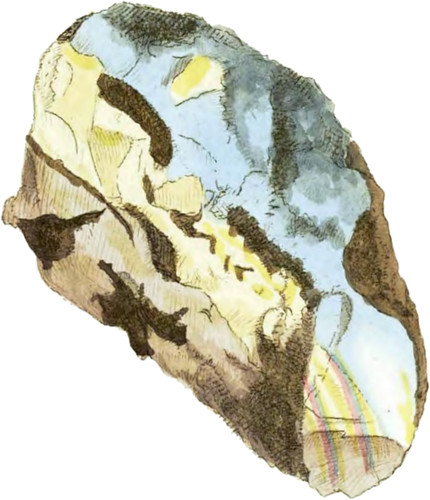 Enlarge
Enlarge
British Mineralogy
Opal
- Class 2. Earths.
- Order 1. Homogeneous.
- Gen. 4. Silex.
- Spec. 1. Quartz.
- Div. 3. Amorphous.
- Syn.
- Quartz resinite opalin. Haüy, 2. 434.
- Opale. De Lisle, 2. 145. De Born, 1. 81.
- Elder Opal. Emmerl. 1. 277.
- Calcedoine irisée, Opale. Daub. 3.
- Halb-opal. Werner.
We cannot, I beleive, boast of very beautiful Opals in England.
The rarity of this gem makes it worthy of notice, and the present specimen shows it passing from Calcedony to Cacholong, and from thence to Hydrophanous Opal, or what has been called Oculus mundi. Lastly, it forms the Semi-opal or Common Opal. The Calcedony is hardly to be distinguished in a drawing, it is the darker part mixed with Copper Pyrites in the figure. The name Cacholong applies to the opaque whiter and softer part, which may be scraped with the finger nail, and will, like all Agates and Calcedony, become more transparent in water. Hydrophanous Opal is the less opaque part, of a greenish hue, and in water becomes like the opal or blueish green part. In this state it resists the finger nail, and, while in water, is not to be distinguished from the Opal, but becomes opaque again when dry.—Common Opal is nearly the same in appearance, either wet or dry, and comprises the grayish, blueish, greenish, and yellowish parts with a milky or waxy lustre, (like the Semi- or Halb-Opal of Werner,) with a vitrescent effulgence or yellowish fiery glare, in some lights, especially in the flaws. Fracture glassy. Hardness sufficient to cut glass.
The most beautiful specimen ever discovered of this substance is in the possession of J. M. Cripps, Esq. of Lewes, in Sussex. It was presented to that gentleman at Constantinople, by his excellency Count Ludolf, envoy from the court of Naples to the Porte. It belonged originally to the Capudan Pacha, and was found in Bulgaria. Unlike the common specimens, in which Opaline Wood appears in small veins intersecting the common Fossil Wood, or in a fragile state like Pitch Stone, it has throughout the whiteness of Cacholong, and in some parts the lustre and colour of the genuine Opal. It is larger than a man’s body, and weighs 148 lb. 93/4 oz. avoirdupois. It presents half the trunk of a large tree, with the node of one of its principal branches. The timber, the bark, and every part of the mass is perfectly opaline.
The Right Honourable Sir Joseph Banks had a Mammoth’s grinder in his possession, lately found on our coast, opalized. Other bones of the Mammoth are found in this country occasionally. I saw a tooth of a Mammoth from America, somewhat opalized, in the late Mr. John Hunter’s museum. There are some also in the British Museum.
Sir Hans Sloan gave 200l for an Oculus mundi now in the British Museum.

